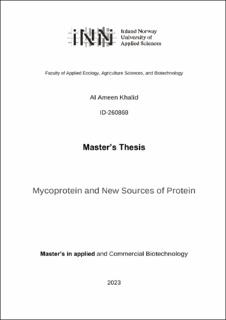| dc.description.abstract | This research paper investigates the potential of Mycoprotein as a sustainable alternative protein source, comparing it to emerging alternatives such as insects and lab-grown meats. Fusarium venenatum is a reliable and effective fungus used as the cornerstone for producing Mycoprotein. This study assesses the viability of establishing a Mycoprotein production facility in Norway, focusing on regulatory obstacles, resource needs, and environmental implications. The market analysis encompasses the identification of diverse market segments and the development of a business plan for a B2C Mycoprotein factory.
Mycoprotein possesses several notable strengths, such as its sustainability, high nutritional value, increasing consumer acceptance, and continuous technological advancements. The weaknesses of the business include limited product variety and production complexity. Opportunities arise from the increasing global demand for sustainable proteins, the presence of health-conscious consumers, and the need to diversify product offerings. Threats encompass competition, supply chain disruptions, consumer skepticism, and potential environmental critiques.
This study expands the comprehension of Mycoprotein's potential as a future alternative protein source and provides valuable insights for stakeholders contemplating its production in Norway. | |
